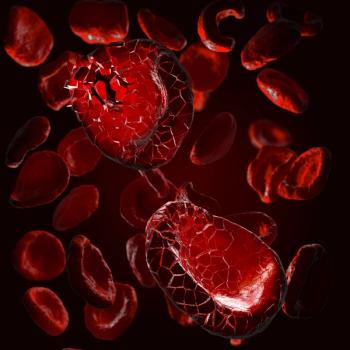
Clinical CRs Seen in Entire Dostarlimab dMMR Rectal Cancer Cohort
No patients with dMMR rectal cancer enrolled on a phase 2 study required subsequent chemotherapy or radiation following treatment with dostarlimab.
All 42 patients with locally advanced mismatch repair-deficient (dMMR) rectal cancer had a clinical complete response following treatment with dostarlimab-gxly (Jemperli), according to data from a phase 2 trial (NCT04165772) presented at the
Additionally, with median follow-up of 26.3 months (range, 12.4-50.5), 24 patients experienced sustained cCR for 12 months.
“[The] cCRs are durable over 2 years, and no patients have required chemotherapy, radiation, or surgery,” lead study author Andrea Cercek, MD, section head of Colorectal Cancer and co-director of the Center for Young Onset Colorectal and Gastrointestinal Cancers at Memorial Sloan Kettering Cancer Center in New York, New York, said in an oral presentation at the meeting.
dMMR/microsatellite instability is a biomarker of reduced chemosensitivity that is present in approximately 5% to 10% of all rectal cancers. Given the reduced effectiveness of standard-of-care therapy in this subpopulation, which consists of total neoadjuvant chemotherapy and chemoradiation followed by total mesorectal excision, and the activity of immune checkpoint inhibitors in metastatic dMMR/MSI CRC, investigators evaluated whether SOC therapy could be substituted with PD-1 blockade.
Investigators enrolled 30 patients, which was subsequently expanded, with stage II or III rectal cancer with confirmed dMMR per immunohistochemistry to receive dostarlimab 500 mg intravenously every 3 weeks for 6 months. After completing treatment, patients underwent radiologic and endoscopic evaluation. Patients with residual disease proceeded to chemoradiation and those with cCR proceeded to non-operative follow-up every 4 months. Patients with residual disease following chemoradiation were taken to surgery and those with cCR underwent non-operative follow-up every 4 months.
“cCR criteria for rectal cancer have been well defined and they include endoscopic exam, which is a visual disappearance of the rectal primary, and a normal digital rectal exam as well as evaluation of an MRI with lack of signal with DWI, and then regression of target lymph nodes,” Cercek explained.
As part of sample collection, circulating tumor DNA (ctDNA), biopsy, and imaging were performed at baseline, 6 weeks, 3 months, 6 months, and every 4 months during non-operative management.
The primary end points were the objective response rate of dostarlimab alone or in combination with chemoradiation and pathologic complete response or cCR rate for 12 months after finishing dostarlimab alone or in combination with chemoradiation. The first primary objective was presented at the 2022 ASCO Annual Meeting and subsequently published in the New England Journal of Medicine.2 Subsequently, dostarlimab was incorporated into the National Comprehensive Cancer Network guidelines for locally advanced dMMR rectal cancer based on the 100% (n = 14) cCR rate displayed in the first read out of the trial.3
“We enrolled 48 patients––the median age is still quite low at 51 [years], but we have a broad range from 26 to 78 years. [This is a] fairly balanced group of patients. The tumors are largely big and bulky, T3 and T4, and about 80% to 85% were node positive,” Cercek said. “The median distance from the anal verge is quite low, at 5.1 cm, so these would require a very low anastomosis, and many of them would require an ATR if we were to undergo surgical resection. [Of the] patients we test[ed] for Lynch [syndrome], we found 51% were positive. The criteria for the trial were dMMR by IHC, but we did test all tumors with next-generation sequencing, and they were all, in fact, confirmed to be MSI-high with a median tumor mutational burden of 53.6. We also have one [patient with] BRAF V600E–mutated [disease].”
Investigators also evaluated the time to cCR via rectal MRI, endoscopy, biopsy, ctDNA, and PET-CT. Overall, the median time to cCR was 6.22 months (95% CI, 6.18-6.45). The median times with rectal MRI, endoscopy, biopsy, ctDNA, and PET-CT were 6.15 months (95% CI, 6.09-6.25), 6.18 months (95% CI, 3.62-6.22), 1.41 months (95% CI, 1.38-2.73), 1.38 months (95% CI, 1.38-2.76), and 2.76 months (95% CI, 2.73-6.18), respectively.
“It does look like initially the endoscopy kind of starts to regress earlier, the tumors regress earlier on endoscopy, but in that 3- to 6-month window, the MRI does catch up. What was the fastest in terms of an indicator of time to cCR was ctDNA,” Cercek noted. “We used a tumor-informed assay with incredibly high sensitivity; 97% of patients had positive ctDNA at baseline, and they cleared it incredibly quickly––more than half of the patients cleared it by the first evaluation at just 6 weeks.”
Regarding safety, the most common all-grade adverse effects were pruritus (13%), rash/dermatitis (21%), diarrhea (9%), nausea (9%), fatigue (11%), fever (6%), and hypothyroidism (11%).
Investigators hope to confirm these findings in the ongoing, global, single-arm, phase 2 AZUR-1 trial (NCT05723562).
Disclosures: Cercek reported stock ownership in Haystack Oncology; serving in a consulting or advisory role for Bayer, Daiichi Sankyo/AstraZeneca, G1 Therapeutics, GlaxoSmithKline, Incyte, Janssen, Merck, and Seagen; receiving research funding from GlaxoSmithKline and Seagen; and collecting patents and royalties for hepatic arterial infusion with FUDR for colorectal liver metastases with DPD (Inst), and neoadjuvant PD-1 blockade in mismatch repair–deficient solid tumors (Inst).
References
- Cercek A, Sinopoli JC, Shia J, et al. Durable complete responses to PD-1 blockade alone in mismatch repair deficient locally advanced rectal cancer. J Clin Oncol. 2024;42(suppl 17):LBA3512. doi:10.1200/JCO.2024.42.17_suppl.LBA3512
- Cercek A, Lumish M, Sinopoli J, et al. PD-1 blockade in mismatch repair–deficient, locally advanced rectal cancer. N Engl J Med. 2022;386(25):2363-2376. doi:10.1056/NEJMoa2201445
- NCCN Clinical Practice Guidelines in Oncology (NCCN Guidelines). Rectal Cancer. April 30, 2024. Accessed June 3, 2024. https://www.nccn.org/professionals/physician_gls/pdf/rectal.pdf
Newsletter
Stay up to date on recent advances in the multidisciplinary approach to cancer.


















































































